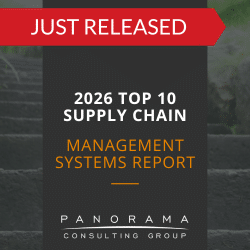We’re now more than halfway into 2023, and the U.S. freight industry is still battling many of the setbacks that plagued it back in 2020. Several issues are happening concurrently. There are concerns over declining freight rail service, a narrowly-avoided strike, and new practices limiting ocean freight bandwidth, just to name a few.
Only by embracing technology trends in the logistics industry can businesses hope to limit the impact of these setbacks.
Today, we’re looking at the technology that is leading this movement and what new adopters need to know.
6 Technology Trends in the Logistics Industry
1. Logistics Software-as-a-Service
While they’re juggling external conflicts, leaders in this space are also trying to keep up with customer demands. This means staying on top of digital trends and embracing new technologies to improve the customer experience.
Enter logistics software-as-a-service (SaaS). Companies that specialize in logistics SaaS communicate directly with clients to facilitate supply chain management. This delivers data-driven insights that logistics leaders can use to improve operations.
2025 Top 10 Manufacturing ERP Systems Report
Are you a mid- to large-sized manufacturing firm? This report is for you. Download it now to learn what kind of advanced functionality is available in the market today.
2. Inventory Management System Integration
Efficient supply chains and reliable inventory tracking go hand-in-hand. Knowing this, logistics companies are looking for ways to improve and upgrade their inventory management systems.
The biggest issue? Their current solutions can’t interface or communicate with their dedicated logistics devices. As a result, workers must manually process and transfer data from one system to the next.
Many companies are finding ways to integrate these two entities more seamlessly. They’re looking at ERP software as well as third-party and custom solutions that bridge the information gap.
Unfortunately, software integration is as hard as it sounds. Ask any software litigation consultant on our team and they will tell you they’ve seen countless companies failing at this endeavor.
Before beginning a system integration project, make sure you have the right strategy and the right skillsets.
3. Autonomous Vehicles
Autonomous vehicles hold great potential in the transportation and logistics sector. As this technology evolves, it could significantly reduce the need for expensive manpower.
When they’re not required to spend hours behind the wheel, workers can put their talents to better use. Meanwhile, the vehicles could be hard at work, tracking and transporting materials without any human involvement (or human error).
Logistics service providers will be able to use AI-powered ERP software to program these vehicles to follow optimized routes with shorter commutes and fewer delays.
4. Augmented Reality
Augmented reality (AR) is especially useful in the logistics and transportation space.
One of the most exciting uses of this technology is AR glasses. When workers slip them on, the data they need is right in front of their eyes. They can use the glasses to perform a variety of tasks on the road, from managing warehouse inventory to accessing real-time routing data and traffic updates.
5. Machine Learning and AI
While its application in logistics is still relatively limited, AI is promising nonetheless.
For example, AI can analyze data inputs from a variety of sources to find ways to improve supplier-partner communication or shorten delivery times.
While some of the most advanced AI may not yet be available (even in the top ERP systems), your company can still benefit from intelligent recommendations, route optimization, and more.
6. Device Consolidation
Gone are the days when logistics workers had to carry around a slew of devices.
Now, they no longer need multiple devices to scan packages, receive signatures, and take pictures for delivery verification. They can do it all from one interface. Then, they can use that same device to monitor driver actions, track vehicles, and create reports.
While these all-in-one tools have obvious benefits on the go, they’re also useful in the warehouse, where employees can use them to perform a variety of tasks, including:
- Locating inventory
- Tracking product movement
- Monitoring inventory levels
Limit the Impact of Labor Shortages, Inflation, etc.
The logistics industry is a sector built on networks and high-speed operations. With so many outside influences threatening this foundation, companies are struggling to meet customer demands.
For many businesses, the light at the end of the tunnel is the prospect of implementing new technology driven by Big Data and AI.
If you’re wondering how to stay on the cutting edge of technology trends in the logistics industry, our enterprise software consultants can help select the right ERP or SCM system and determine how AI fits into the picture. Contact us below for a free consultation.














